A strict diet may not be necessary for you. Good food choices begin with a proper mindset.
Living a more anti-inflammatory lifestyle can – over time – improve your body composition, your skin’s appearance, and your overall health. The motivational video located lower within this article can help you get started.
Depending on your unique situation, enhancing your health may be as easy as making a few key lifestyle changes and food choices – and perhaps changing how you think about food in the first place.
Here are small improvements that will help you start living an anti-inflammatory lifestyle today without following a strict diet.
Some of the strategies are specific and practical – such as substituting healthier food choices in place of inflammatory snacks.
Other strategies are more philosophical and involve shifting a previously held attitude into a new outlook.
This is because our beliefs form the foundation of our daily lives, and evolving them can make improving habits much easier.
1. Stop Worrying About How Other People Live
We underestimate the extent to which our culture influences us.
As children, we absorb secret messages from our environment about what is normal.
These messages come from our families of origin, local culture, media – and society.
Most of these messages hit our brains on an unconscious level (children’s brains, especially, are like dry sponges – what they are exposed to, they soak up).
If we are raised in a culture where cold cereal or toast is standard breakfast fare, then other ideas about breakfast will seem like an eccentric, strict diet for the rest of our lives.
And when we entertain other ways of eating, we will see ourselves as magnanimous and open-minded – even if the “eccentric” way is more compatible and beneficial to the human body.
People think swinging by Starbucks on their way to work for coffee-and-muffin-to-go is “normal.” However, just because you’re not going to follow a super strict diet doesn’t mean you can’t still make nutritional upgrades.

Upgrading lifestyle habits is a difficult process.
The older we get, the harder the process becomes.
We’re always bumping up against those pesky childhood associations of what is normal.
Decide that you want to move past cultural associations and begin living in a way that supports your body, psyche, and soul – whether or not it jibes cultural norms.
As long as you’re living in integrity and kindness, it’s nobody’s business what you eat – even if it seems like a strict diet to others.
How you organize your time and energy as an adult is completely up to you.
Action Step: for the remainder of today, I invite you to notice which of the daily habits and automatic behaviors you engage in are inspired by what truly serves you (or the standard operating procedure in our culture).
2. Understand that “Longevity” Means “Health Span”
What do you consider to be a strict diet?
Does a strict diet mean choosing not to eat something you currently eat quite often?
While the medical community focuses on miracle breakthroughs that will allow future generations to live well beyond 100, we can make beneficial changes in our lives now that will lengthen the number of years we can remain flexible, positive, and vigorous.
It’s particularly helpful when you can repeat a new, healthier choice long enough for it to turn into an actual habit – so that it’s a part of your brain’s wiring and your body’s muscle memory.

Longevity means more than just having a long lifespan. It also means:
- enjoying excellent physical health in later years
- having high energy
- experiencing daily joy
- a post-50 life that is rich in meaning and purpose
- having a significant positive impact on the lives of others
“You cannot judge the value of a life by its quantity. It is by the joy that you are feeling. The more joyful you are, the longer you live. Let yourself relax and breathe and be free and be joyous, and romp. The optimum physical life experience is to have plenty of things that stimulate you to desire, and an awareness of the way you feel, so you’re reaching for thoughts that feel good — so you’re wide open, so you’re tuned in, tapped in, and turned on.”
Abraham-Hicks
You likely have more freedom than you realize.
Ailments are sometimes blamed on bad genes or a family history of short lifespans. While some traits are certainly hereditary, our lifestyle habits often decide when bad genes are turned on.
Medical doctor and researcher Dr. Terry Wahls has determined that today’s standard American diet activates 65 genes that increase inflammation, whereas the Wahls Paleo Diet turns on 72 genes that decrease inflammation.
Recent longevity data made available by the Social Security Administration reveals:
- men living to 65 today can expect to live until age 84 on average
- women turning 65 today can expect to live until age 86
- one out of every four 65-year-olds today will live past the age 90
- one out of 10 will live beyond the age 95
- one in 6,000 from birth could expect to live to be 100.

Average Life Expectancy:
- US average = 78 years
- Canada = 80
- US state of Hawaii = 83
- Japan = 83
- UK = 81
- Australia = 83
The danger in believing that lifespans are hereditary or culturally predetermined is that they can cause people to give up on attaining optimal health.
Through better fitness and healthier food choices, people can reverse their fortune.
It doesn’t even have to require a strict diet (in fact, a helpful aspect of Dr. Wahls’ protocol is that it provides three different levels of eating – beginning, intermediate, and advanced – depending on one’s goals and current health challenges).
“I often ask people if they are a product of nature or nurture and I try to make a point that it’s neither. It’s a product of choice. You can choose your response to both nature and nurture.”
Steven Covey
3. Use Stevia (or Monkfruit Extract) instead of Sugar to Avoid a Strict Diet
If you take nothing else from this article, take this with you: one of the best things you can do for your health is to remove refined sugar from your daily diet.
Eating less sugar might feel like a strict diet, but it quickly gets easier (the first three weeks are the hardest).
Freeing yourself from a sugar addiction can be among the eating hacks that will most transform your life.
However, there are still beneficial ways to enjoy a sweet snack.
You can replace refined sugar with modest amounts of stevia – a sweetener extracted from the leaves of a plant without any carbohydrates or artificial chemicals – or monk fruit extract.
If I could go back in time and change only one nutritional habit, it would be to have never consumed so much sugar.
Stevia was a helpful tool for me in kicking the sugar habit; however, it takes a bit of experimenting to figure out how to use stevia in the exact way your taste buds will most appreciate.
Using too much stevia powder or liquid will add a peculiar aftertaste to your food. The trick is to use just enough (a little goes a long way). I find monk fruit extract tastes a little better.
It will help you to remember that all carbs eventually become sugar in the body – though, at least vegetables are complex carbohydrates that can sustain energy.
Even fruit – good for you in small intermittent doses – can be damaging if it’s ingested relentlessly.
Simple carbohydrates are addictive and can wreak havoc on the body as we age – especially when consumed in excess. I’m not saying that sweeteners like stevia and monk fruit are good for you. They can sometimes mess with your gut biome and ability to absorb nutrients. However, compared to sugar, they are probably the healthier alternative. Ask your doctor.
4. Upgrade Your Calcium without a Strict Diet
I just had my annual physical exam, and my medical doctor reports that my bone health is now excellent.
However, a year ago, this was not the case.
I had been exercising regularly – doing Olympic lifting, sprints, and cross-functional fitness exercises – and my body was starting to look and feel better. Then, I suddenly started to have bone issues.
I began developing little spurs and other injuries from my high-impact activities.
I visited a naturopath to pinpoint what might be missing in my diet. My blood and urine lab tests revealed that the calcium supplement I had been taking was not getting the job done.
Doctors and nutritionists are now beginning to discuss the difference in the quality of calcium supplements.
Some calcium supplements are rock-based, and I discovered a vast difference in the quality of those supplements.
I also learned that calcium supplementation is one of those nutritional areas where it’s wisest to obtain the best you can afford.
A year later, my bones are strong, and I’m having great workouts again.
After that previous experience with injuries and lack of calcium absorption, I became intrigued by how the skeletal system functions optimally. I am now much more conscious about improving my bone health.
Improving our bones’ wellness can subsequently improve our entire bodies’ health.
Depending on how active you are and your average daily diet, you might be getting all the calcium you need from the food you eat. On the other hand, you might not.
Ask your medical doctor, and consider focusing on those calcium supplements derived from whole foods.
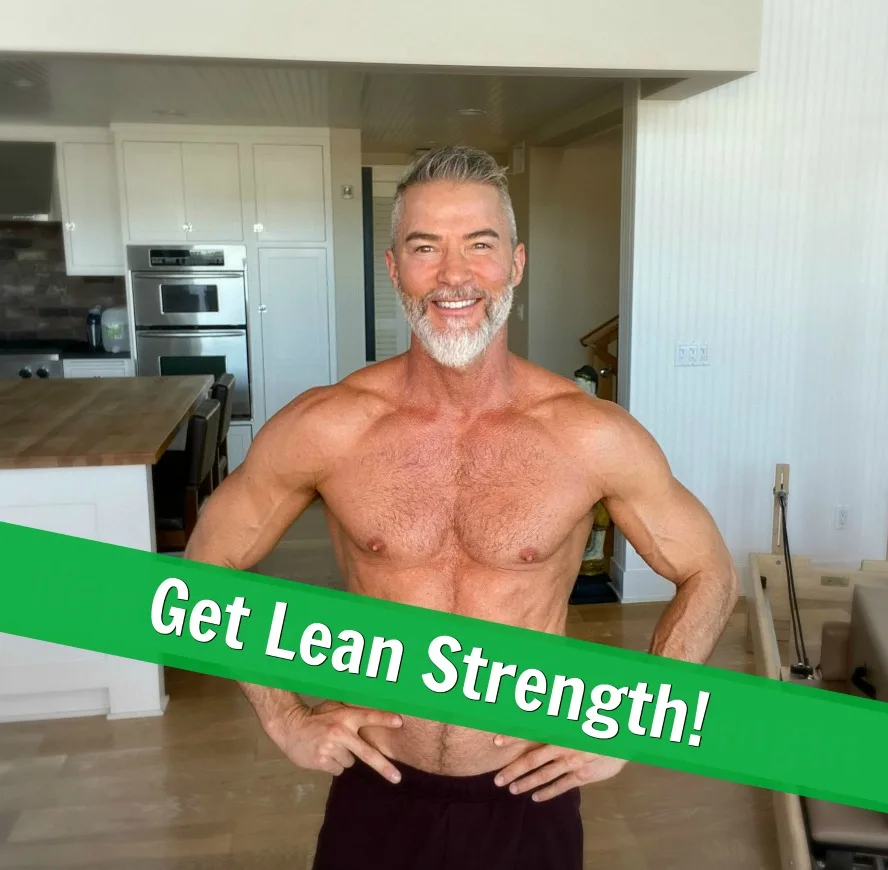
5. Track Your Calories At Least Twice a Year
I find it beneficial to track my calories twice a year for a typical day of eating.
To me, having to count calories each week of every year would be a too-strict diet. But twice a year? That I can handle.
In tracking your caloric intake, you might find that – instead of a strict diet – you simply need to remove approximately 250 calories from your average day.
Strategic food choices can make removing 250 calories per day practically painless.
A calorie is a unit of energy:
- When we consume more food energy than our bodies need, they get stored in our fat cells, making them bigger.
- When we consume fewer calories than our bodies burn that day, that stored energy within the fat cells is used, and the cells become smaller.
When you’re meticulous about checking how many daily calories you want – versus how many calories you eat – you are often surprised to discover that you were a bit off in your assessment.
“For every extra 100 calories a person eats (or drinks) each day, that adds up to 10 pounds at the end of a year. Just 100 calories! You know how EASY that is?”
Dr. Chris Mohr
Using a calorie calculator, you can easily figure out how many calories you want to consume each day – based on your age, gender, average activity level, and personal goals.
When using these online calculators, remember to strive for brutal honesty when guessing your typical activity level.
“Very active” means you move regularly, and your work and hobbies are also physically active. Unless you’re a carpenter who trains for triathlons during off-work hours (or something similar), you probably don’t want to check the “very-active” box.
In other words, we tend to underestimate how sedentary we are.
After using the calculator, you’ll have two numbers:
- the losing number
- the maintaining number
If your calorie consumption stays at, or under, the losing number, it means you lost body fat that day.
If your consumption stays at or below the maintaining number, you didn’t add any fat that day.
Armed with those numbers, you can now write down everything you eat on a typical day. Everything. Afterward, you can figure out how many calories that adds up to.
Finally, you can then freshly craft an ideal day of things to eat that keep you within your target numbers.
As you undergo this process, I encourage you to keep your sense of humor about it. All you are doing with this exercise is giving yourself realistic information to make better choices based on what you want for yourself.
Try not to think of this process as a strict diet but as an adventurous experiment. If your attitude becomes too rigid or self-shaming, you risk activating the inner rebel. So keep it light and try to have a bit of nerdy fun with it.
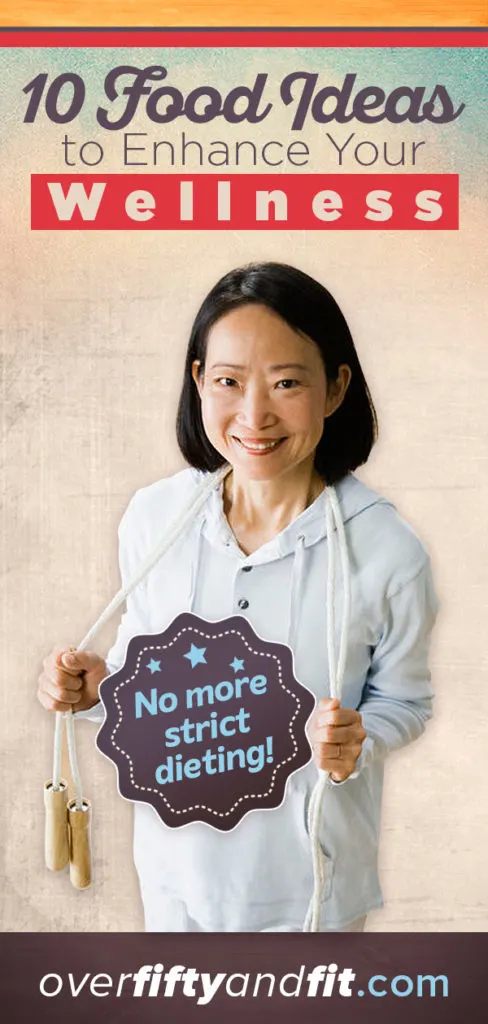
Not only do the amount of calories count, but so does the quality. I invite you to keep those calorie choices as anti-inflammatory as possible.
Another benefit to tracking your calories periodically is that whenever you consult with a health professional – your medical doctor, nutritionist, or naturopath – you can bring along your tracking sheet and show them what you eat on a typical day.
This, in turn, assists them in making the best decisions on your behalf.
I believe that when my overall health improves, so does my metabolism. When my metabolism is regulating more efficiently, my body fat stays lower.
Later in your nutritional journey, you might become less interested in counting calories and more interested in how many grams of healthy fat and protein you consume daily. Athletes call that “tracking macros.”
6. No Strict Diet, But Do Limit Your Coffee Intake to 1 Small Cup a Day
Because you’re not on a strict diet, you can still have coffee. But not in excess.
Coffee is a fascinating beverage – it can be good for you or bad for you, depending on how you use it.
Coffee is loaded with powerful antioxidants. A recent New England Journal of Medicine study reveals that coffee might add years to your lifespan, and according to the Life Extension Foundation, coffee is unusually rich in natural compounds that interact favorably with the cells of the human body to:
- reduce vascular disease
- preserve cognition
- mitigate diabetes
- slash cancer risk
- turn on genes that promote youthful cellular functions
- lower the risk of death
Alternatively, there are some startling ways that the brewed liquid made from roasted seeds can be detrimental to your well-being:
- The caffeine in coffee can interfere with important sleep cycles. The human body’s importance in receiving a deep and restorative sleep cycle each night cannot be overestimated.
- Coffee is potentially addictive. If you drink enough of it for many days in a row, then one day you will wake up and no longer merely want it, but rather, you’ll need it to function.
Stranger still, if you’ve had daily coffee for many weeks in a row and then one day you decide to skip it, you’ll probably notice that you get a headache and have withdrawal symptoms.
“The main health-promoting substances in coffee and tea are polyphenols – in particular catechins and epicatechins. Lab and animal studies say these molecules have anti-inflammatory and antioxidant properties. Harvard-led studies of large groups of people over time have found that tea or coffee drinkers are at lower risk for diabetes and possibly cardiovascular disease.”
Harvard Medical School
An easy way to tell if you’re addicted to coffee – or anything else – is to ask yourself: can I imagine my life without it?
When you can’t even picture your morning without coffee or remember your morning ritual before coffee came along, you’re possibly addicted to the substance.
Coffee is acidic, and generally, it’s helpful to keep your body’s pH balanced toward alkalinity.
Some health experts believe that when your body’s chemistry lives habitually in an acidic state, it can contribute to health problems.
Coffee can overstimulate delicately balanced systems because it’s so stimulating.
Some health experts believe that too much habitual, daily use of caffeine can ultimately negatively impact the human body’s small adrenal glands – basically over-stimulating them into eventual exhaustion.
Drinking coffee can be fattening. While coffee itself is 98.5% water and only has about 5 calories per cup, the fact remains that many people no longer drink their coffee black like in the old days.
Specialty coffee drinks are increasingly popular, and they are loaded with calories.
For example, a Starbucks large mocha cookie-crumble “frap with extras” might contain over half of your day’s allotted calories.
I used to have several cups of caffeinated coffee every morning, but ultimately I decided that getting that huge jolt of caffeine in the morning, for 365 mornings in a row, might not be the healthiest thing for my body. Today, I prefer Swiss Water Decaffeinated (the caffeine is removed from the coffee bean without harsh synthetic chemicals, and the coffee has a mellow, woodsy flavor that I enjoy.
I ease into my day more gently with black, ginger, nettle, or green teas.
But if giving up all caffeine seems like an overly strict diet, try reducing caffeine to one small cup of coffee daily.
7. Do 5-Minutes of Conscious Breathing Daily without a Strict Diet
Dr. Andrew Weil has often asserted that stress is a primary factor in aging.
If you want to feel better and look better in your day-to-day life, you must keep your stress levels as low as possible (consistent, low-level stress is a true ager to the human body).
You can melt the tension from your face and decrease your body’s cortisol levels – the stress hormone responsible for accelerated aging – by doing five minutes of simple, conscious breathing each day.
Dr. Weil shares a scientifically proven breathing technique:
- inhale, for a 4 count
- hold, for a 7 count
- exhale, for an 8 count
Now, repeat the above 4 times in a row.
8. Consume Less Processed Carbs and More Healthy Fats and Raw Foods
An anti-inflammatory lifestyle is a way of living to reduce exposure to irritants in one’s eating and environment. Unless you have a chronic health condition, it can be done without following a strict diet. It’s just about being slightly better about what you do most of the time.
When you begin to understand that inflammation and glycation are two of the primary causes of accelerated aging, it can inspire you to reconsider the role of food in your daily life and to consider an anti-inflammatory lifestyle.
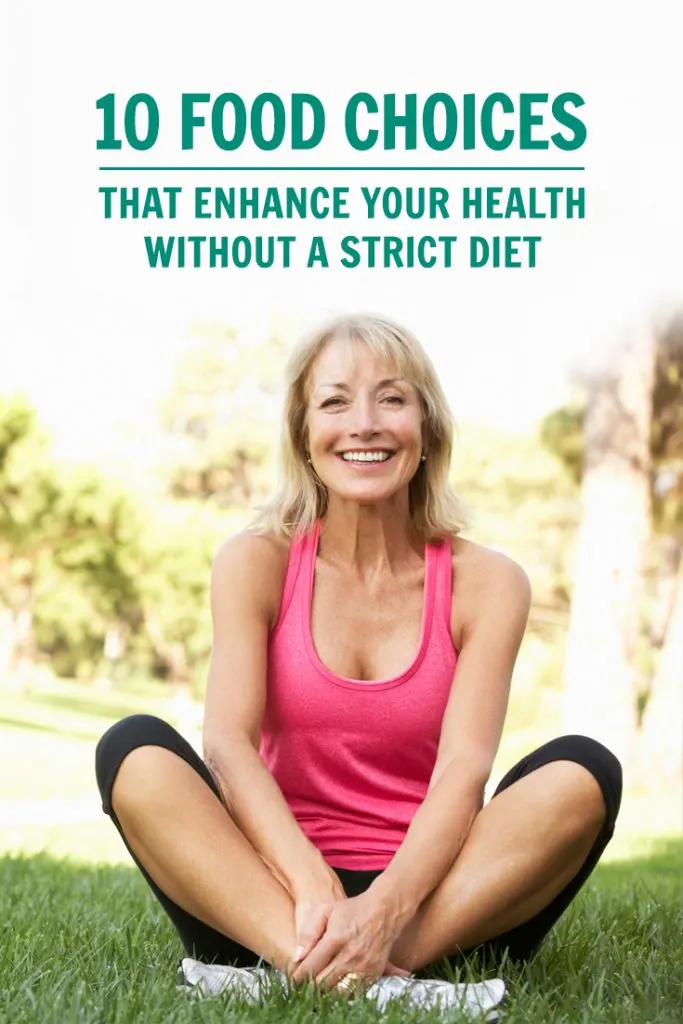
Inflammation occurs when your body grows tired of habitually having to process things it would rather not process, and glycation is when your body begins to imperfectly regulate the relentless amount of sugar it is exposed to, causing oxidative damage.
The first step is to develop a genuine curiosity about which foods are harming and which foods are healing to the unique chemistry of your own body.
Trends come and go in the world of gourmet food.
I remember in the late ’80s when fats were “out,” and carbs were “in.”
Almost every magazine on the shelves was extolling the virtues of a high-pasta diet (that seems so funny now, but it was the case back then).
A decade later, high-protein was all the rage.
Carbs were considered a necessary evil, best indulged in the smallest amounts possible.
This brings us to a time when diets are more balanced but no less extreme.
What’s in style now are food regimens that are more primal, emphasizing more fresh fare like our ancestors ate, and less “conveyor belt” foods from the industrial age.
Is This a Strict Diet?
Among the currently popular lifestyle, diets are Paleo and Raw Food.
It might seem that these diets are complete opposites since Paleo is heavy on meat, while Raw Food is often considered a vegan undertaking and a strict diet. However, these two diets have meal plans with much in common. Namely, they emphasize the virtues of vegetables.
The raw food regimen is not a weight loss diet.
Yes, one usually drops a great deal of body fat when eating an all-raw diet, but the primary purpose of raw food is to improve health and vitality (the fat loss is just an added perk).
Technically, the raw food regimen is a way of eating that emphasizes plants and limits food choices to those uncooked – or at least not exposed to temperatures of over 104° F (or 40° C).
There has been talking among some nutritionists lately that – while most vegetables are better raw – there are a few vegetables that might have a broader nutritional spectrum when slightly cooked.
Raw foodists believe that many beneficial enzymes and nutrients in fresh produce are lessened when cooked at high temperatures.
There is no one way to follow a raw food diet. Some raw-fooders are fully committed and do 100% raw, believing that all plant-based foods are healthier – with their complete enzymes intact – uncooked.
Other health enthusiasts believe that a 100% all-raw food intake is an unnecessarily strict diet and instead opt to make mostly (not all) raw food choices. They typically aim for a 70% intake.
There are even more subsets within the raw food community:
- those who eat all-raw but include raw meat (such as our ancestors ate before the era of agriculture – this is another place where the raw food diet and Paleo diet converge a bit)
- the spiritually inspired health-conscious who believe uncooked foods have a quality that is unquantifiable in a lab test: namely, an abundance of “prana,” or lifeforce
- there are even raw-fooders who drink red wine!
Consider making super salads for dinner on most nights.
Include your favorite vegetables and lettuces, but also try varieties you’ve never before considered.
Top off with microgreens (such as sunflower sprouts) and raw, sprouted nuts and seeds.
Often, our bodies will give us the information we need to make good choices if only we will listen.
Your body will often tell you if you have a sensitivity (or an allergy) to any particular food. Did your energy drop or go up after you ate?
Remember to give your body time to acclimate to the increase in fiber.
Depending on how optimized your intestinal flora is – with good probiotics and such – your body may take a bit of time to get used to the uptake of fiber in your daily diet.
Your stomach may grumble a bit at first.
As you get healthier, however, you will eventually become far less gassy than you were before the dietary increase in living raw foods.
Aside from super salads, another easy way to begin incorporating more raw foods into your diet is by drinking freshly made green smoothies.
There are certain meals and snacks that – though they may seem strange at first – enhance wellness and improve body composition.
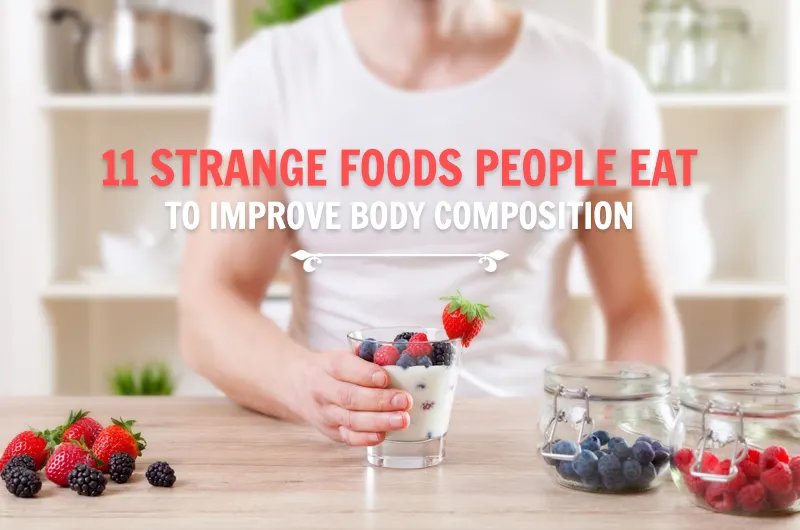
Life is for living, so I say: do what brings you joy in the long term.
Speaking personally, I like to experiment – to see if particular diet, exercise, or lifestyle changes can help me feel better. Even if it means eating strange foods that I might not have considered previously, especially if these foods might improve my body composition.
Strange foods only seem peculiar because we’re unfamiliar with them.
Hitting the High-Carb Brick Wall
All those years I lived with a sweet tooth – eating a high-carb/ low-fat diet – caught up to me, and I began to feel poorly as my body composition worsened.
In this case, my body fat percentage increased beyond levels I considered healthy.
Eventually, I realized that nutritional upgrades would be the wisest course of action to feel fantastic and improve my body composition.
If you told me back when I was a young fellow that I would be eating the strange foods I do today at age 58, I might not have believed you.
In my case, eating this way now has me feeling better than I have in decades.

Body Composition is the Ratio of Fat Tissue to Muscle Tissue in Your Physique
Body composition typically refers to the fat to muscle ratio within someone’s body.
From a dietary perspective, this ratio tends to be optimized when someone consumes just enough complex carbohydrates to fuel their workouts, enough protein to help muscle cells repair and recover, and an abundance of healthy fats to provide ketone calories and improve the luster of skin and hair.
I’m not suggesting that you – or anyone – eat exactly how I eat. For some, it would seem like a strict diet.
I get asked a lot about my diet and daily lifestyle, so this article is my current answer to those questions.
The eleven strange foods that I – and other people following an anti-inflammatory lifestyle – often eat are:
- matcha green tea or ginger tea (in place of caffeinated coffee)
- cultured coconut milk (in place of dairy yogurt)
- raw sprouted chips (in place of cereal, oatmeal, or toast)
- freshly made green smoothie (in place of juice, soda, or Red Bull)
- full-fat coconut milk (in place of dairy cream)
- No Cow bar or 22-Days Bar (in place of a candy bar, whey protein bar, or granola bar)
- free range grass-fed bison (in place of conventional ground beef or hamburger)
- a large amount of freshly prepared vegetables (in place of burritos or pizza)
- kombucha (in place of wine)
- food-based nutritional supplements (in place of standard synthetic vitamins)
- MCT oil (on an empty stomach to switch from glucose or “sugar energy” into mild ketosis)
Below, you’ll find more specific examples of what I eat on a typical day and why I eat that way.
Body composition is a term that indicates leanness – the proportion of fat and fat-free (bone, water, and muscle) mass in a human body. Ideal ratios typically include a lower percentage of fat cells (but not too low).
Many health professionals use body composition to measure a person’s overall health and fitness level.
As long as you experiment with an upbeat attitude of curiosity (shame-free and with a sense of humor), it can be a lot of fun discovering exactly how your body is nourished and what protocols it responds to most positively.
Strange Foods I Eat at Age 58 to Transform My Body Composition (without Having to Follow a Super Strict Diet)
- 8.25 hours of sleep each night
- a tall glass of water upon waking
- ginger, nettle leaf, matcha green, or decaffeinated green teas (I usually blend my hot tea with unsweetened coconut milk, a 1/2 teaspoon of sprouted-rice protein powder, a 1/2 teaspoon of bone-broth collagen protein, and a drop or two of stevia. Makes a subtle and smooth tea latte.)
Breakfast
- unsweetened coconut yogurt with raw, sprouted chips; cultured or fermented foods can beneficial to your intestinal flora – the good bacteria in your gut
- instead of yogurt, on heavy-workout days, I will opt instead to have a small serving of bison meat for breakfast
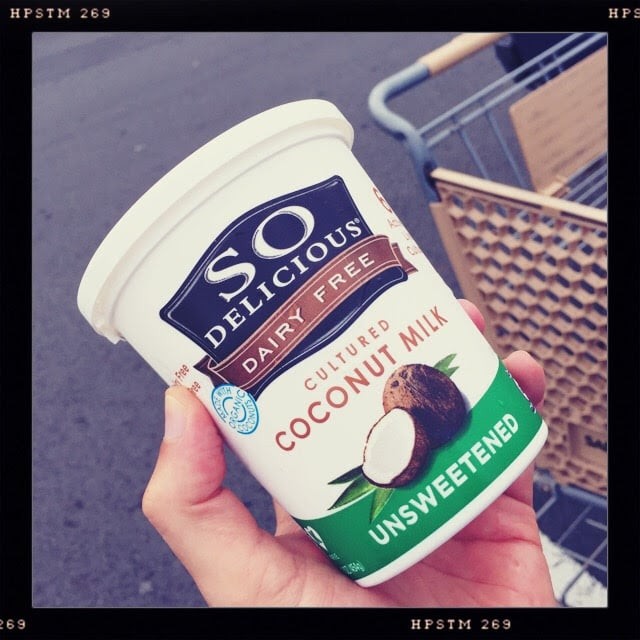
Mid-Morning
- green smoothie (brazil nut, flax seed meal, blue-green algae, cucumber, broccoli, kale, spinach, cilantro or parsley, romaine, celery, water, and perhaps a few drops of fresh lemon juice if needed)
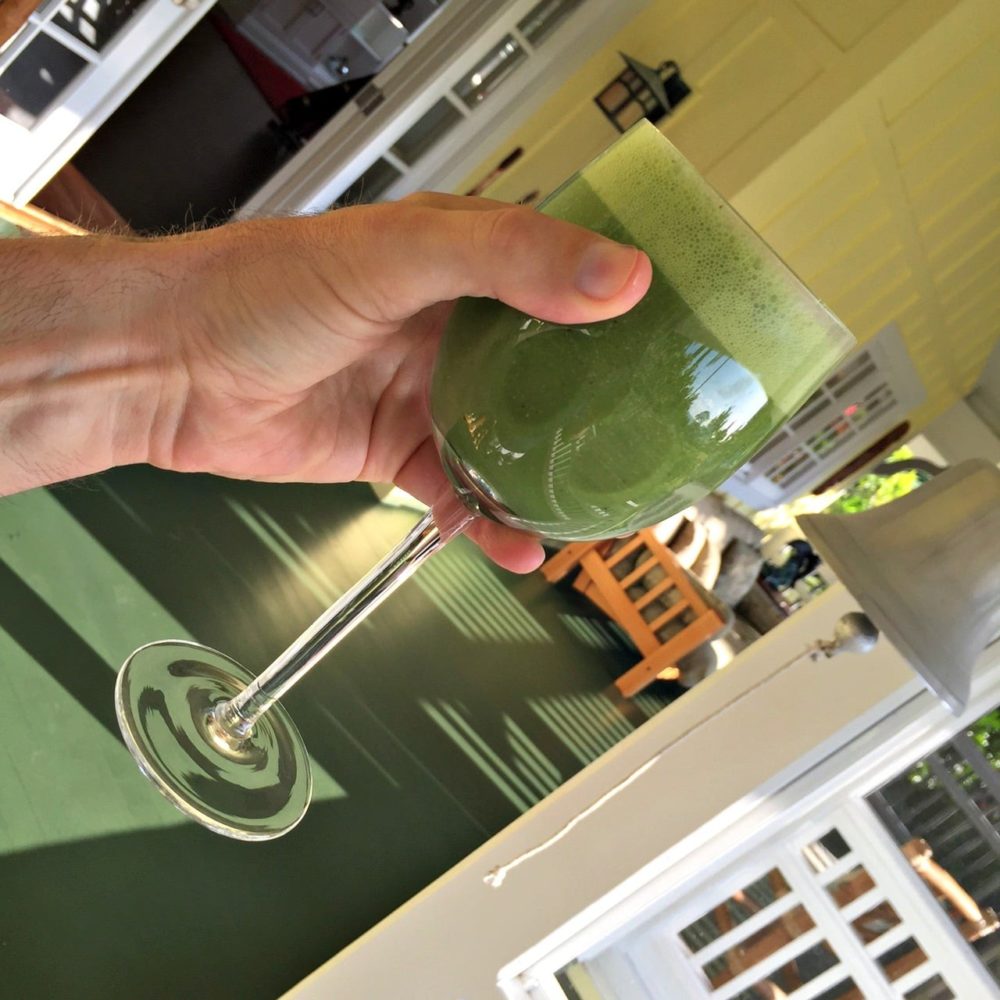
Snack
- black tea blended with full-fat coconut milk, cardamom, and plant protein
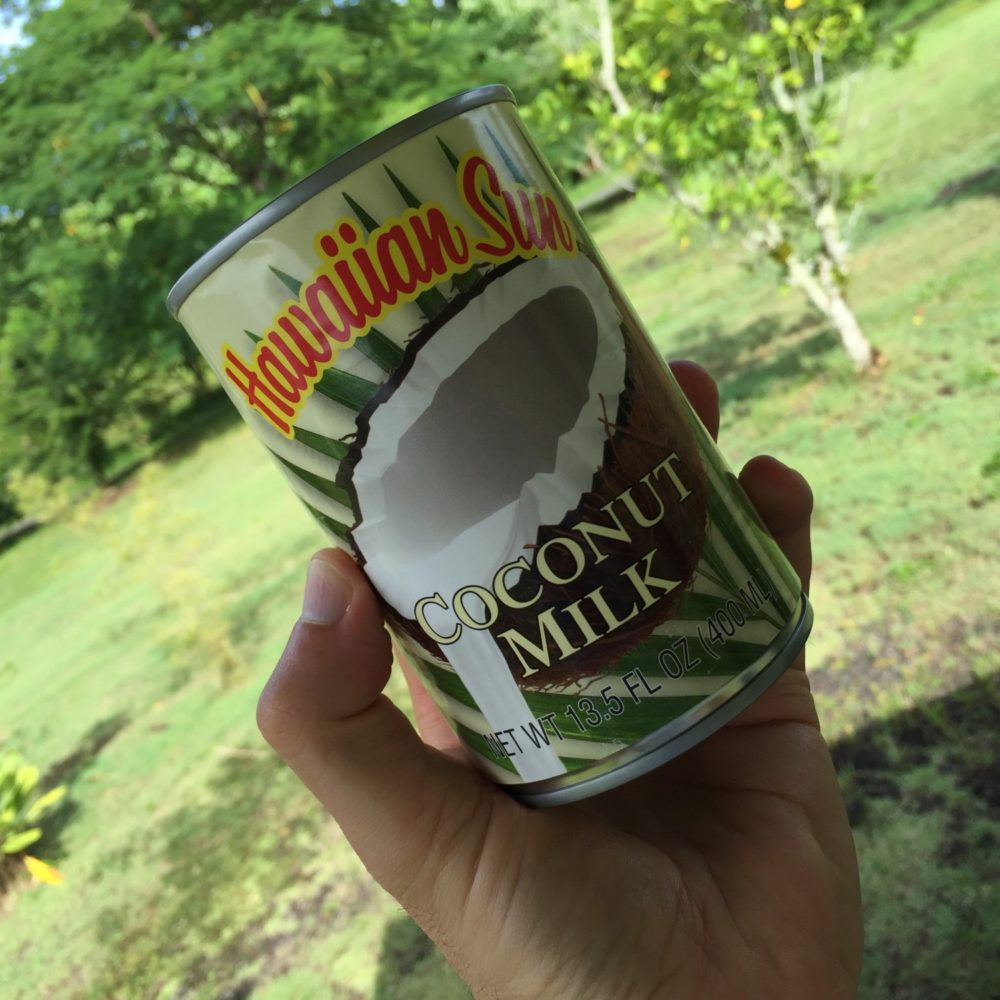
Lunch
- a small serving of leftovers: animal protein and vegetables (bison, turkey, chicken, or fish)
Snack Idea without a Strict Diet
- No Cow Bar (blueberry or lemon) or 22-Days Bar (salted caramel).
Dinner
- animal protein and vegetables (bison, turkey, chicken, or fish)
Dessert
- a small glass of kombucha OR a small green smoothie, and 1/2 an apple with almond butter (but on heavy workout days, I might have all three)
Nutritional Supplementation
Among the strange foods I consume are food-based enhancers. To fill in any potential missing gaps, I provide my body with extra assistance in the form of nutritional supplements: examples of some of the supplements I take intermittently are:
- digestive enzymes
- N-A-C (300 mg/Jarrow)
- diosmin (orange peel extract, for vein health)
- food-based calcium/magnesium
- pancreatrophin PMG (Standard Process)
- sublingual B-12 spray
- livaplex (Standard Process)
- immuplex (Standard Process)
- Vitamin D3 (1000 IU)
- Food-Based Multi-Vitamin
- Ultimate Omega (Nordic Fish Oil)
- Zinc (MegaFood)
I cycle on-and-off of supplements.
There is no supplement that I take every day of the year.
Before Bed
- a 1/2 spray of sublingual melatonin
- and I get my bed ready with earplugs, a white-noise fan, a black eye mask, and soundproof headphones.
Wellness Hacks without a Strict Diet
- intermittently (once or twice a week), I supplement with SP Prolamine Iodine or CoQ-10
- I have strategic sport recovery supplements twice a week on heavy workout days – trace minerals, sea salt, beet extract, amino acids, etc.
- When I’m between meals, I sometimes have a large tablespoon of olive oil/avocado oil/MCT oil – together with a digestive enzyme – to give my brain calories to burn and achieve trace-level ketosis – until my next meal.
- I was motivated to try eating this way because of autoimmune challenges.
- I work closely with a medical doctor, a dermatologist, and a naturopath; I think of them as my Wellness Team. They know all about my strange foods.
- my favorite nutritional supplement companies, at the moment, are Standard Process (SP), NewChapter, Biotics, and Jarrow.
- I try to find an animal protein that is grass-fed/free-range whenever possible and when the budget allows for it.
- If I have two smoothies on the same day, I change the ingredients for each. Sometimes I add a bit of fresh lime juice or a small chunk of frozen banana, avocado, or berries. For vegetables, I might add kale, spinach, chard, watercress, parsley… all kinds of vegetables.
- when I’m cheating, I’ll have vegan dark chocolate (stevia-sweetened, usually).
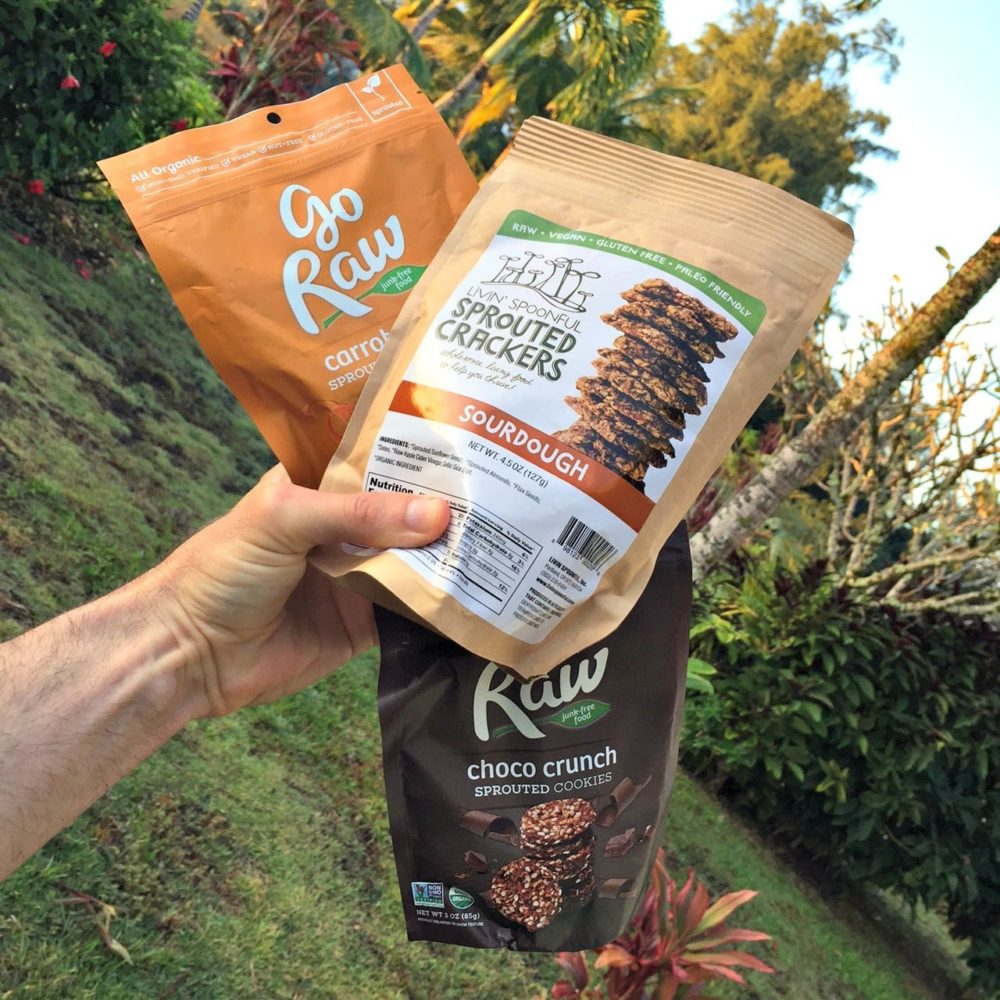
Everyday Foods VS Infrequent Foods
Not all foods are everyday foods. Some foods are every-other-day foods. Some strange foods are just for rare occasions.
What foods you can have every day without developing a sensitivity to them probably depends on your own unique body chemistry.
For example, in my opinion, these foods are not ideal to consume every single day for most people:
- bread/toast/bagels
- cooked eggs
- cereal (hot or cold)
It’s a good idea to keep a close eye on how many flour or grain products you consume each day, the quality of those products, and how they impact your body composition.
My own life experience has taught me that eating too many poorly prepared, low-quality grains will create belly fat and a puffy face.
Many doctors, researchers, and longevity experts now believe that the two biggest factors of aging are inflammation and glycation:
- inflammation is when your body has been bombarded with irritants for so long – and in such large amounts – that it eventually gets tired, confused, and starts attacking itself
- glycation is when sugar begins to impact the tissues inside your body in a negative way.
In my opinion, most flours and grains contain enzyme-blockers and lectins that disrupt our own body’s digestive enzymes. Over time, our bodies can respond to these lectins as if they are toxic proteins and so will pad our midsections with visceral fat to protect our vital organs from toxicity.
Flour is made from grains. Grains are carbohydrates that will convert to sugar inside your body. Your body probably has had too much sugar already.
We need carbohydrates to live and thrive, but too many carbs (such as those currently found in the standard American diet) can be problematic.
How Many Grains Are You Consuming Each Week?
I used to consume too many grains.
Chronic inflammation is the root cause of most diseases, and many people find that dairy, sugar, processed grains, and refined flours – though they can taste good in the moment – have negative after-effects.
Though our modern culture doesn’t consider grains among its list of strange foods, when you look at the timeline of human history, you will discover that carbs in these extremely high amounts are strange and have only become commonplace recently.
Flour is an ingredient in many items available at your grocery store. If right now I asked you to guess how many grains you eat, on average, each week – you would probably underestimate the amount. It’s just human nature to fudge the numbers. For example:
- most people overestimate how much water they drink and how healthy they eat
- most people underestimate how sedentary they are and how many calories they consume.
The only way to know how you’re actually doing on your self-care protocols is to – once in a while – pay close attention to what you eat, drink, and move, and then carefully track it.
Once you know your choices on a standard day, you can begin experimenting with improvements.
I experience positive results for my own body by having a daily diet that consists mostly of fresh vegetables. To a smaller degree, I also consume fruit, sweet potato, and lean meats.
I now believe that how much animal protein a person has or doesn’t have can depend on the unique chemistry of her body and her movement level (some people thrive on a vegan diet, while others thrive on a paleo-style diet).
Also, a diet can be modified based on where one is in the life cycle. A particular style of eating that might work well at age 27 might not work so well at age 58 (I’ve noticed that active children can often get by with more flour and dairy products in their daily diets without negative consequences).
While I believe each person must find their way and discover for themselves what strange foods are the most helpful, it’s safe to state that – generally – the more anti-inflammatory a diet is, the better one’s health will be.
Over the last year, I have lost 18 pounds. Much of that has been fat-cell weight loss.
Once I reach 25 pounds of weight loss, I will add more calories to my daily menu so I don’t lose any more weight.
I expect adding an extra serving of clean animal protein during the day will probably help me to maintain my weight and muscle-tissue ratio at healthy levels from that point forward.
- Have you ever experimented with transforming your body composition?
- How would you change your body composition – reduce fat cells, increase strong muscle tissue, or combine both?
9. A Freshly Made Green Smoothie instead of Cereal or Toast in the Morning
It’s a true accomplishment to start your day with vegetables, and a green smoothie makes that deliciously possible.
Green smoothies may be among the best eating hacks.
Ingredients for a green smoothie include nuts and seeds, green vegetables, a little fruit, and ice.
When made properly, a green smoothie tastes good and sustains you with quality stamina throughout your morning.
Get yourself an excellent blender and discover the energizing effects of freshly made green smoothies.
Your first few shakes might be a near-disaster, but you can make the best green smoothies with a little patience and a sense of adventure.
10. Decrease Consumption of Synthetic Food Additives
Ever wondered why certain fast foods and processed foods taste so good?
Many of today’s food products contain synthetic flavor “enhancers.”
These enhancers are added under misleading names that sound harmless and are in almost all packaged foods – with names like textured vegetable protein, sodium caseinate, spices, and carrageen.
An anti-inflammatory diet seeks to reduce the number of chemical additives consumed in food.
Dr. Russell Blaylock, a prominent neurosurgeon, in his book Excitotoxins: The Taste That Kills explains how certain food additives can negatively affect the development of a child’s nervous system – stating that these same chemical food additives may precipitate neurodegenerative diseases like Parkinson’s disease, ALS, and even Alzheimer’s disease:
- Food additives are compounds that companies add to food products to enhance their flavor and color or prevent spoiling.
- Dr. Blaylock calls these chemicals added to many modern food products “excitotoxins” because they cause certain brain cells to get excited and fire off signals rapidly.
- The brain cells can be so active that they become exhausted and die off, leading to neurodegenerative diseases.
It’s important to understand that canned foods have lower nutritional value than fresh food and that there are potential issues from the plastic liners used in cans and the chemicals that might leak into the food.
When a Strict Diet Might Be Helpful
Today we see many children with attention deficit disorders, autism, mood disorders, and mental illnesses.
Practitioners have seen children with seizure disorders that, when taken off processed foods and fed Essential Fatty Acids (EFAs) and organic homemade baby food, had a disappearance of their seizures.
Jim Harris was a medical doctor and oral surgeon in Canada before he relocated to the US to start a naturopathic practice to help people increase wellness while preventing disease. Dr. Harris asserted that infant formulas and processed foods can be loaded with flavor enhancers that may harm children’s developing brains.
Harris said, “I have worked with adults with debilitating neuromuscular degenerative diseases that show not only a stop in the progression of their disease but at least partial recovery by following an anti-inflammatory lifestyle along with the addition of certain nutrients.”
“It’s a known fact,” added Harris, “that a person with multiple sclerosis can get significantly worse for days or weeks after eating just one meal with flavor enhancers.”
When modern humans eat an inflammatory diet and live a sedentary lifestyle, they habitually wake up with a puffy face and slouchy posture, and – gradually – their body’s cellular health begins to degrade.
Fortunately, simple lifestyle choices do the opposite – they help us appear lean, strong, and energized.
If you “stack” enough self-care protocols into your average day, the result is that you will probably live more joyfully.
At the same time, you will also be modeling self-care for the people you most love – you’ll be showing them by example the benefits of valuing one’s health.
“Legacy is even more important to me than longevity,” a friend said recently.
The positive difference we make in the world is more important than how long we live. Fortunately, the two are not mutually exclusive.
The anti-inflammatory lifestyle is a way of living in which a family or individual “stacks” positive nutritional habits and self-care protocols to improve daily quality of life by:
Though perhaps not its primary purpose, an anti-inflammatory lifestyle can lengthen life expectancy while improving skin’s appearance.
The shrinking of fat cells is another common – and often welcomed – side-effect of an anti-inflammatory diet.
Making the best food-related choices now can help us avoid having to eat a strict diet later.
Additional Sources about Making Strategic Food Choices and the Pros and Cons of a Strict Diet:
Coffee’s Protective Effects – https://goo.gl/O6Hsnx
Coffee-Growing Process – https://goo.gl/hRFVCv
The Physical Side of Kicking Bad Habits – https://goo.gl/iO2c2D
The Truth about Bone Health – https://goo.gl/hRN7Kr
Paleo and Autoimmunity – https://goo.gl/hu2UkM
Calcium Magnesium Supplementation – https://goo.gl/8JWQhU
Predicted Cancer Rates for US – https://goo.gl/ZwCeYa
More Benefits of an Anti-Inflammatory Lifestyle and Autoimmune Protocol – https://goo.gl/OPCgTx
Dangers of Glycation and When to Eat a Strict Diet – https://goo.gl/Hckfb6
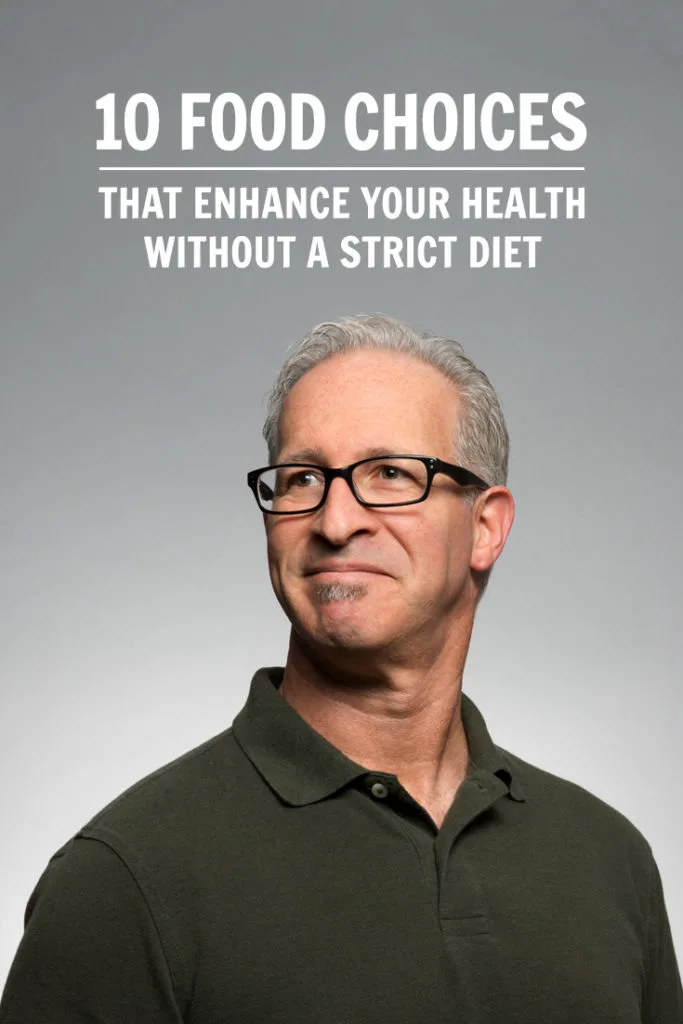
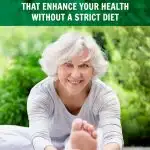
Leg Day: A Lower-Body, Functional-Training Workout • Over Fifty and Fit
Saturday 4th of January 2020
[…] the video. This one is a great finisher – it really burns the calories as it strengthens your heart and lungs. Plus, whatever juice you have left in your leg muscles will […]
This Ankle-Weights Workout Will Sculpt Your Physique • Over Fifty and Fit
Thursday 2nd of May 2019
[…] old-fashioned leg lifts target the outer thigh and help add shape to the glute. 20 […]
Pilates Is Uniquely Effective Workout for Mature Men
Saturday 13th of April 2019
[…] I don’t mean a conventional college degree, I mean whatever valuable information, life lessons, and skills you have acquired over the years – whether this information was in a classroom, a […]
Benefits of Removing Sugar and Grains from Your Daily Diet
Sunday 7th of April 2019
[…] is, they are fun to eat while you are eating them. However, as soon as you are done eating, that fun feeling often […]
Live a Brilliant Life with this 3-Point Manifesto • Over Fifty and Fit
Sunday 24th of March 2019
[…] not mean you have to sleep on a straw mat in a bare room; it does mean that you’ll probably feel better when you live the simplest version of the particular life you were meant to […]